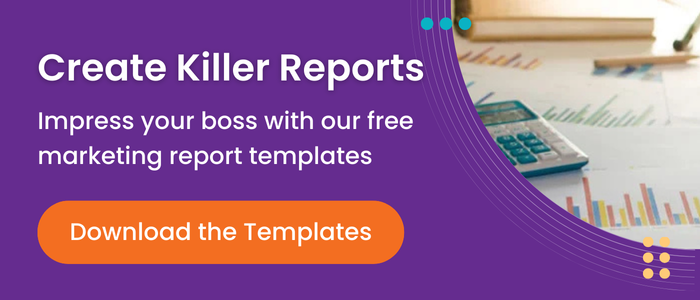9 Ways to Hit Your Marketing Goals Before Year End

As December winds down, you’re probably thinking a lot about those marketing goals you set at the start of the year. Did you crush them? Or were those stretch goals too much of a stretch?
We hope you were able to hit every target you needed to hit. But if a few of your numbers are still just out of reach, read on. We have some quick ways to boost your results before the year is over. You’ll look like a hero to your boss – and maybe you’ll even get some more money in your budget for next year!
Of course, the specific tips we have to offer depend on the marketing goal you’re trying to reach. Do you need to bring more traffic to your website? Generate more leads? Increase revenue? Here are ideas to grab some fast wins in each of those categories.
For guidance on setting SMART marketing goals, check out this post!
Marketing Goal #1: Bring more traffic to your website
Normally, a full-scale strategy to increase website traffic would mean launching a comprehensive SEO program. But SEO takes time, and if you’re trying to rack up some quick wins, you need tactics with immediate results – like these:
Publish an extra blog post this month
Can you squeeze in one more article before the holidays? The goal here isn’t strictly about getting found in the search engines (although you should still write your post with SEO in mind). Instead, rather than simply publishing it on your website and hoping that Google finds it, try doing more with that blog post:
- Send it to your database of contacts via email. (This is usually automated if you use a platform like HubSpot.)
- Publish it as a LinkedIn article and share it with as many groups as you can.
- Share it on your social media accounts and pay to boost the post’s reach.
Send a blog roundup email
The end of the year is a great time to send one more email to your database: a roundup email of your top three to five most-read blog posts of the year. Even better: These roundup emails are easy-peasy to write.
Review your analytics to see which posts were the most popular over the last 12 months, add a blurb to let your contacts know why you think the posts resonated so well with so many people, and boom – done.
Run a digital ad campaign
This year we’ve helped our B2B clients see tremendous success with targeted campaigns on LinkedIn. Or, you may decide that Google Ads or Facebook advertising is a better fit for your audience.
Whatever your platform, throwing even a small budget at paid digital advertising can be a great way to quickly bring new eyeballs to your content. If you’re new to digital ads, HubSpot has a great tutorial blog post to get you up to speed.
Marketing Goal #2: Generate more leads
Bringing traffic to your website is important, because that’s how you generate leads from your website. After all, your goal isn’t just bringing traffic per se – your goal is to get all those anonymous website visitors to figuratively raise their hands and let you know they’re interested in learning more about what you sell.
This can be a high hurdle for many marketers to clear. But these three suggestions will help you convert more of your website visitors into leads:
Add a CTA to every web page
Does your website have any dead-end pages? These are pages where the visitor reads all the way through to the end and then – nothing. The web page provides no instructions, no next steps, no nothing.
Dead-end web pages are a big no-no in inbound marketing.
To fix this, go through every page on your website and make sure that each page provides the visitor with clear instructions for what to do next. The instructions could be many different things, such as:
- A CTA for a blog post or downloadable resource that offers more information.
- A hyperlink to another one of your web pages on a related topic.
- A link to the Contact Us page so the visitor can have a sales rep contact them.
- A phone number or email address so the visitor can easily connect with a sales rep.
Whatever your CTA is, the point is to know what logical next step your visitor should take, and then make sure your visitor knows exactly what to do.
Related Content: 10 Call-to-Action Examples You’ll Actually Want to Click
Implement Smart CTAs
So, you’re following inbound marketing best practices and you have a powerful CTA at the end of each blog post that directs the reader to a related, deeper-dive content offer.
What happens if the reader happens to have already read that content offer? They’re obviously not going to bother clicking on that CTA, will they?
If you’re a HubSpot user (at the Professional level or higher), there’s an easy solution to this problem: smart CTAs.
With smart CTAs in HubSpot, you can show different CTAs to different visitors, depending on specific criteria you identify, such as lifecycle stage or list membership. There’s quite a lot to say about smart CTAs, but fortunately HubSpot has already created a guide for you!
Add a new form to every thank you page
When your website visitors convert on a content offer, typically this means they’ve visited a landing page on your website and submitted a form on that landing page. Usually, the visitor is then redirected to a thank you page where they can download the content.
That thank you page is a terrific place to add a new conversion opportunity.
Often, thank you pages are fairly simple – with a short “thank you and here’s your content” message along with a button to download the content. This means you probably have a lot of real estate to do more!
What might your reader be interested in after reading your content offer? What other content do you have for the next stage of the funnel? Add that offer as a new form right on the thank you page and make it easy for your reader to proceed through their buying journey.
Pro tip: Make the form on your thank you page a smart form using progressive fields. That will ensure you’re not asking your lead the same old questions every time; instead, you’ll be enriching your database with even more valuable information with every form submission.
Marketing Goal #3: Increase revenue
Revenue, of course, is the holy grail for any business. And while, strictly speaking, closing deals is generally the responsibility of your sales team, there are a few things you as a marketer can do to help them along.
Send a year-end sales email
Why not leverage your contact database to prime the pump with a year-end sales message? The email doesn’t need to be fancy – and in fact, the plainer the email is, the less sales-y it will feel.
Simply ask your contacts how their year has been, whether they’re looking for any help hitting their year-end goals, or whether they’re looking ahead to get a jump start on the new year – and then let them know you (or your sales reps) have ideas or solutions that can help. Add a big, clear call to action that lets the reader know how to get in touch with you or your sales rep, and voila: a quick and easy way to grab any low-hanging, sales-ready fruit.
Review your lead nurture campaigns
You do already have lead nurture campaigns set up, right? Automated emails that are sent to leads after they convert on your website, to encourage the lead to engage with more of your content and hopefully guide the lead further along the buying journey?
Good.
But let’s make sure they’re working. Because these emails usually have much smaller send volumes than your bigger, targeted content offer campaigns, it’s easy for lead nurture emails to escape the same level of scrutiny you give to those bigger campaigns.
So, grab your analytics and see how your lead nurture emails are performing. If any open or click through rates aren’t where they should be, take a moment now to make some fixes.
Related Content: Benchmarking Your Email Marketing Statistics: What’s Normal? [Data]
Identify sales-ready leads with lead scoring
Lead scoring is like giving your sales reps the gift of time: By quantifying which leads are the most engaged, you enable your reps to prioritize the leads they pursue, so they’re focusing their energies on the leads most likely to close.
Setting up a new lead scoring system can be complex and requires thinking through which activities indicate a highly engaged lead. And even once you’ve set it up, you may need to tweak your algorithm a few times before you get it just right.
But trust us: Setting up lead scoring is definitely worth the effort.
You can find great tutorials on lead scoring by ActiveCampaign and HubSpot.
Pulling It All Together
It’s easy at this point to sit back and say, “Well, it’s a really busy time of year for me right now, so maybe I’ll try some of these tips in January when things slow down.”
Don’t fall into that trap.
We both know that when you’re a marketer, things never really slow down. But that also means it’s always a good time to make small but smart changes that will cumulatively have a big impact on the marketing goals you need to achieve this year.
Rally your team together and put in a late-in-the-year effort. You’ll be glad you did.
If you don’t have a team, enlist the help of a great inbound marketing agency like Clariant Creative. We speak your language, and we love to roll our sleeves up and help you do big things. Let us know how we can help you reach your marketing goals!
You might also find our marketing reporting kit helpful. This downloadable zip file includes a ready-to-use Excel spreadsheet and PowerPoint template that will help you pull together accurate, attractive reports that prove your marketing ROI.





